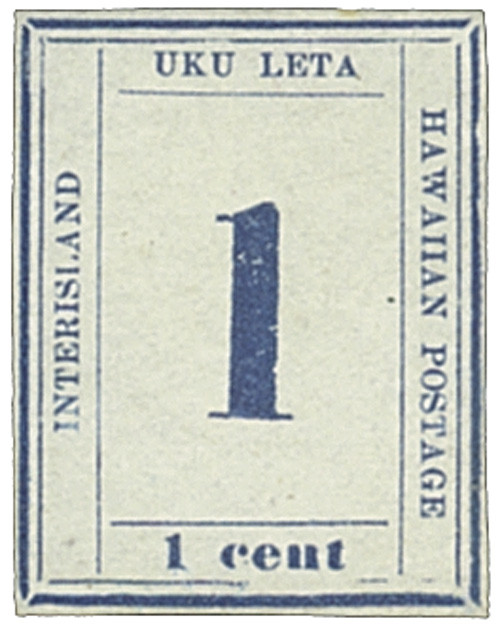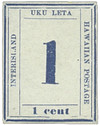The “Plain Border Numerals” used the same rudimentary printing methods as the Missionary stamps. The same type and rules were used throughout the printing of the Numerals, emphasizing their utilitarian nature. Unlike the stamps picturing Kamehameha, these stamps were printed in Hawaii instead of Boston, eliminating the long wait between the time the stamps were ordered and their arrival in the islands. The first printing was done at the office of the Pacific Commercial Advertiser. The owner of the office was the first postmaster of Honolulu, H.M. Whitney. The stamps were ready for public use on August 1, 1859.
The Postmaster General of the Sandwich Islands at this time was Alva K. Clark. Mr. Clark was uncertain as to the future of the postal system of the Sandwich Islands. As a result, he was exceedingly conservative when ordering the printing of the “Numeral” stamps. Some of the larger post offices were given as few as 200 to 500 copies of the desperately needed 1¢ and 2¢ stamps at the time of the first printing.
The second printing was done soon after the first, because the supply of stamps was dwindling. In October of 1859, a second printing of Numeral stamps was done. Even though the supply from the first printing was nearly depleted, Mr. Clark still considered the future of the island’s postal system dubious, and a small supply was ordered once again. The stamps were printed in the same newspaper office by Whitney.
A fray had developed between Whitney and Postmaster General Clark over the issue of whether or not inter-island newspapers could be sent without a postal charge. Whitney, publisher of The Pacific Commercial Advertiser, was under the impression that inter-island newspapers did not require postage, while Mr. Clark did not believe this to be so. Hence, all printings of the Plain Border Numerals, after the second, were done at the Government Printing Office.
In 1862, a robbery occurred at the post office, and books, documents and stamps stored in a safe were stolen and discarded in a sewer. Some of the books were recovered, but the stamps were lost. Around the same time the ship Polynesia, which was delivering U.S. stamps to the islands, was consumed by fire. These two events created a severe shortage of stamps requiring yet another printing of these stamps. The Plain Border Numeral Stamps were printed a total of nine times.
Wove Paper
This term is generally used for any paper which is not “laid.” The tightly woven wire upon which the wet pulp rests during the paper making process leaves an imprint on the paper’s surface.









